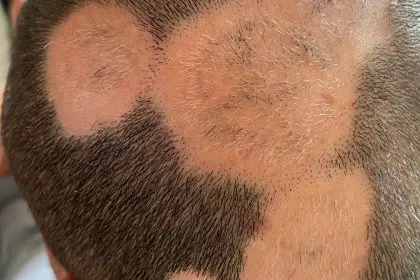
Hair defines many things for a woman – personality, attractiveness, success, health and social status, just to name a few. Losing it can have a dramatic effect on both self-esteem and social life.
I’m a licensed cosmetologist who’s been in the industry for 23 years. I became a certified non-surgical hair replacement specialist in 2004 and in the last seven years have witnessed more Alopecia (hair loss) than ever. Is it due to negligent hair stylists, people doing their own hair and not having the skillset or medications and radiation treatments? The answer is all of the above.
In most cases, clients have come to me and their stories are the same: they’re victims of negligent stylists only concerned about creating a good looking style no matter how it’s achieved and to make a quick buck. The results are receding hairlines, traction alopecia, bald spots and more.
In other cases, clients admit they allow their sister, friend, cousin or neighbors to do their relaxers, color and other services – all can be damaging if not done properly by a professional. The homemade stylist, otherwise known as the “kitchen-tician,” leads to the same result: Alopecia, poor porosity and elasticity, over- or under-processed hair due to negligent use of chemical relaxers and extremely tight hair braiding that has caused permanent damage to the hair follicle.
In other cases, there are some women who just suffer from Female Pattern Baldness, medically called Androgenetic Alopecia. This is due to a chemical called Dihydrotestosterone (DHT). DHT builds up around the hair follicle and eventually kills both the hair follicle and the hair. The hair follicle’s resistance to DHT is genetic, so if any of your family members have thinning hair, there’s a pretty good chance you may experience the same at some point.
One major form of Alopecia, which most people are not familiar with because it’s not commonly discussed, is Alopecia Totalis, also called Alopecia Universalis. This form of hair loss begins at any time in your life. It is an autoimmune skin disease that often baffles doctors. Clients’ stories include losing a quarter or nickel-size patch of hair on different parts of the body. After they are treated for the chronic disorder, the hair returns then even more falls out until there are bald spots. Clients wake up and see large clumps of hair on their pillow. With Alopecia Totalis (Universalis), a client ends up completely bald – all over – even down to their eyelashes, eyebrows and Lanugo hair (the baby fine hair we all have on our face, arms, etc.).
There are many other reasons why women lose their hair. Hormonal imbalances, postpartum/stress, chemotherapy, and disorders such as trichtilliomania, hair loss caused by compulsive pulling or twisting until it breaks off, as well as prescription drugs or menopause.
One can be affected by a variety of medical conditions that can destroy hair follicles. Symptoms include itching, irritation or soreness. If you’re experiencing any of these symptoms or have unexplained hair loss, make an appointment for a scalp analysis by a professional or a microscopic scalp analysis by a non-surgical hair replacement specialist or trichologist – a person specializing in hair and its disorders.
Sharmele “Smiley” West’s mother was a sufferer of Androgenetic Alopecia, which began mildly over a decade ago and because of this, she became a certified non-surgical hair replacement specialist. She’s met many Alopecia sufferers, heard their traumatic stories and seen damage she didn’t even know existed. Today, she’s moving forward with her research and collaborating with certified trichologists.
Contact Sharmele for a free consultation.
Smiley’s National Black Hair Institute (NBHI)
1861 Mountain Industrial Blvd Suite 103
Tucker, GA 30084
678-580-2092
[email protected]














